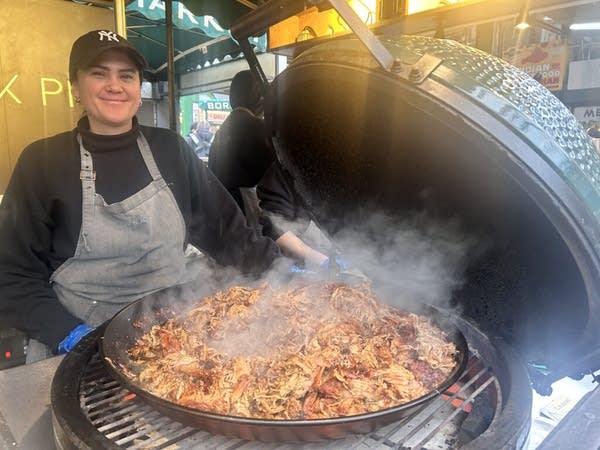How London’s millennium-old Borough Market has evolved to serve modern tastes
London’s Borough Market, a stone’s throw from the Thames, attracts roughly 20 million visitors a year.

This story was produced by our colleagues at the BBC.
Just off the main road, 100 stalls nestle between several Victorian railway viaducts. It’s quite cool — twinkling fairy lights all around under high, vaulted arches. The site is London’s Borough Market, which is one of the city’s most popular food markets and attracts about 20 million visitors a year. We’re a stone’s throw from the Thames and London Bridge on an ancient site. There’s been a market around here for a thousand years.
There’s a strong smell of Stilton coming from somewhere, to my left Taste of Croatia, a bread stand to the right, plus a fun stall called Spice Mountain.
Some 30 years ago, this was a struggling wholesale market. But it has been reinvented as a fashionable foodie destination and, in turn, helped reinvent once down-at-heel Southwark. It’s run by a charity that brought in $10 million last year, with investment properties helping to subsidize the market.

Stark’s Fruiterers has been run by the same family for decades. Richard Stark is manning the stand and he told me a key principle: where possible, buy local.
“When everything’s in season in the summer, we’ve got a lot of farmers in Kent that we know. We’ve got good cherry suppliers, apple suppliers. A lot of the veg comes from Kent, but obviously this time of year it’s all imported,” he said.
But just as prices can spike, rents and overheads have also risen. Annual rent for a large, prime pitch rose in line with inflation to about $1,100 a month in 2024. Then there are service charges on top.

It can be tough to get a pitch, but Seafood specialist Shellseekers has been here for 27 years. Jed Hall peaks his head over a fillet of fresh salmon. The trick to keeping costs down and standards high, he said, is skipping the middleman.
“We’ve got our own boat down in Dorset. We’ve also got friends with boats that we buy fish from,” he said. “Obviously, we’ve got the cost of the boat, cost of the fishermen that work on the boat, cost of the regulations and licenses that you need. That has unfortunately come back to the customer.”
Judy Wall is next to me, eyeing up the turbot and the brill. She’s a regular customer who loves fish but gets out of cooking it.
“My husband cooks it. He’s very exact,” she laughed, “and he knows when it’s cooked.”
I plunge in further when I get called across to Atlantic Edge, a stall with rows and rows of oysters on display — all as a train rumbles overhead.
Out from under the railway viaduct, you come to an open courtyard littered with food stalls. You can’t miss the sizzle of the Black Pig’s pulled pork sandwiches, priced at the premium end: $16. Manager Tayla Welham said the stall has grown from a small team thanks, in large part, to Instagram and TikTok.
“I’ve been here two years and since then there’s been massive growth,” she said. “I mean, there was a team of eight of us; now, we’ve got about 30+. It does get very busy here. It’s one of the oldest food markets in London and also being in the public eye, knowing people are filming you all the time. It’s cool, it’s great, it’s fun to be a part of.”

But some traders aren’t so comfortable with all the attention. Over at Humble Crumble, a bright pink dessert stall known for apple-and-cinnamon crumble, I spy a sign asking customers not to film their staff. Emily Broughton is the supervisor there.
“Most of our customer base obviously are great but because it’s so huge on social media, everybody is filming — which is absolutely fine — but we just don’t like to have our staff — their faces — filmed,” she said.
Borough Market is a place where old traditions merge with modern tastes, and where the crowds are drawn to Insta-fame rather than the wholesale trucks of old.








